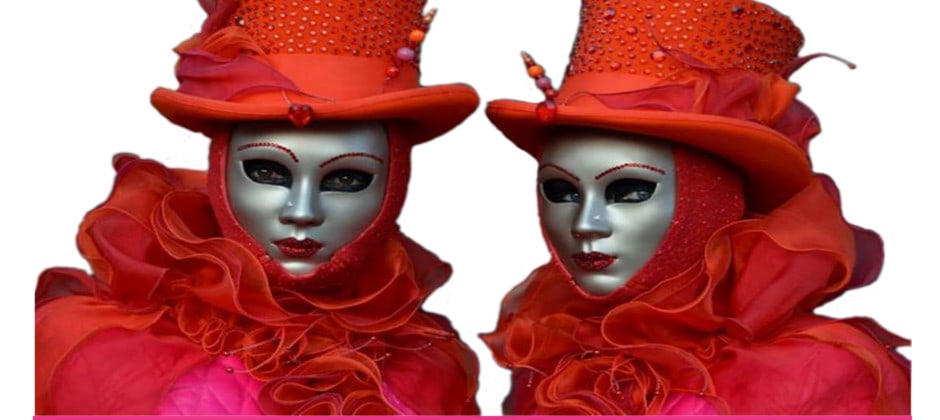
Venice Carnival
The Venice Carnival was always one of the most popular feasts in the city, and records documenting this event go back as far as the eleventh century.
The Venice Carnival: History, Traditions, and Typical Recipes
The meaning of the word “Carnival” comes from the Latin “carne levare” or carnelevarium, which means “to remove meat.” This expression referred to the religious prescription of abstaining from meat starting from Ash Wednesday. However, the preceding period became an occasion to celebrate with festivities echoing ancient Greek Dionysian festivals and Roman Saturnalia.
The History of the Venice Carnival
The Venice Carnival is one of the most beloved and famous festivals in the world. Its origins date back to the 11th century, with the official tradition beginning in 1162 to celebrate the victory of Doge Vitale Michele II over the Patriarch of Aquileia. The celebrations started with the butchering of a bull and 12 pigs in Piazza San Marco, but over time, they were enriched with masks, costumes, and lavish dances, transforming into a celebration full of charm and mystery.
From the 1400s to the 1500s, the festivities were regulated due to the excesses of the masked crowds. Despite the Church’s efforts to contain transgressions, the Venice Carnival remained an event symbolizing freedom and opulence, unique in its kind.
The Carnival reached its peak in the 18th century, when Venice became the heart of European entertainment. The celebrations lasted nearly six months, attracting travelers from all over the continent. With the fall of the Venetian Republic in 1797 and the Napoleonic invasion, the festival was abolished, only to be restored in 1979 by the Municipality of Venice. Today, the Carnival is one of the most spectacular events in the world, attracting tourists from every corner of the planet.
Carnival Party at Hotel Carlton on the Grand Canal
For an unforgettable experience, book the Carnival Party at Hotel Carlton on the Grand Canal.
The evening includes:
- Dinner Aperitif with Live Music
- DJ Set and Dancing until Late: Perfect for immersing yourself in the magic of Carnival.
Book now to experience the Venice Carnival like never before.
Venetian Carnival Sweets: Frittelle and Galani
The Venice Carnival wouldn’t be complete without its delicious traditional sweets: Venetian frittelle and galani.
Venetian Frittelle (Fritole)
Carnival frittelle, known in the local dialect as “fritole,” are one of the signature sweets of the festival since the Renaissance. Originally prepared by the “fritoleri,” a dedicated guild, these treats were sold in the streets to satisfy the desires of masked revelers.
Traditional Venetian Frittelle Recipe:
Ingredients:
- 25g yeast
- 300g flour
- ¼ liter milk
- 100g sugar
- 3 eggs
- 50g butter
- 70g raisins
- 30g pine nuts
- Lemon zest, 2 tablespoons rum or brandy, salt
- Oil for frying
Instructions:
Dissolve the yeast in warm milk, whisk the eggs with sugar, then add melted butter, yeast, raisins, pine nuts, lemon zest, and rum. Add the flour and knead until smooth. Let rise for one hour, then fry the dough in hot oil and serve the frittelle dusted with sugar.
Galani di Carnevale
Galani, crispy and thin fried pastries, have origins that date back to ancient Rome. Perfect for making at home, galani are a simple and irresistible sweet.
Traditional Galani Recipe:
Ingredients:
- 500g flour
- 100g sugar
- 50g butter
- 2 eggs
- 125ml grappa
- Salt, lemon zest, oil for frying, powdered sugar
Instructions:
Mix all ingredients until smooth dough forms, roll it out into a thin sheet, cut into diamonds, and fry in hot oil. Serve the galani dusted with powdered sugar.
Why Choose the Venice Carnival?
With its unique atmosphere of elegant masks, masquerade balls, and centuries-old culinary traditions, the Venice Carnival is a magical experience that everyone should live at least once in a lifetime. Book your trip and immerse yourself in the timeless charm of the lagoon city during Carnival!





 HOTEL CARLTON CAPRI
HOTEL CARLTON CAPRI LA CUPOLA RESTAURANT
LA CUPOLA RESTAURANT TOP OF THE CARLTON SKY LOUNGE
TOP OF THE CARLTON SKY LOUNGE HOTEL CARLTON ON THE GRAND CANAL
HOTEL CARLTON ON THE GRAND CANAL



















